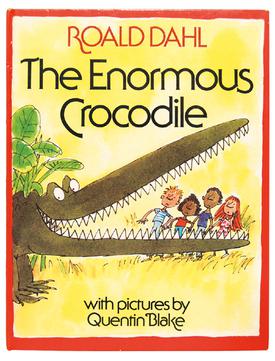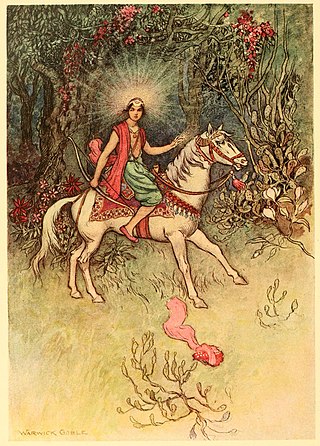
"Hansel and Gretel" is a German fairy tale collected by the Brothers Grimm and published in 1812 as part of Grimm's Fairy Tales. It is also known as Little Step Brother and Little Step Sister.

"The Golden Goose" is a fairy tale collected by the Brothers Grimm.

The Enormous Crocodile is a 1978 children's story written by British author Roald Dahl and illustrated by Quentin Blake. A picture book written for younger readers than Dahl's other works, the story is about a hungry crocodile who aims to eat children via using various, not-quite-impenetrable disguises.
The Vuanirewa is the ruling tribe (yavusa) of the Lau Islands, a scattered group of more than a hundred islands and reefs along the eastern edge of Fiji.

Seasons of Giving is a 1999 American direct-to-video animated musical film which included A Winnie the Pooh Thanksgiving, and two episodes from The New Adventures of Winnie the Pooh. It features new songs by The Sherman Brothers, and the final time that Paul Winchell voiced Tigger.
How the Dragon was Tricked is a Greek fairy tale collected by Johann Georg von Hahn in Griechische und Albanesische Märchen with the title Von dem Schönen und vom Drakos, and sourced from Kukuli. Andrew Lang included it in The Pink Fairy Book. It is Aarne-Thompson type 328, the boy steals the giant's treasures.

I Yam What I Yam is the second Popeye theatrical cartoon short, starring William "Billy" Costello as Popeye, Bonnie Poe as Olive Oyl and Charles Lawrence as Wimpy. The source of the quote is the comic strip, Thimble Theatre by E. C. Segar, in which Popeye first appeared. This is a paraphrase of words spoken by Popeye in the comic strip.
The Fool and the Flying Ship, an audio performance based on the Eastern European folk tale, is a part of Rabbit Ears We All Have Tales series, and is narrated by Robin Williams, illustrated by Henrik Drescher and features music composed by the Klezmer Conservatory Band.

"The Gnome" is a German fairy tale collected by the Brothers Grimm in Grimm's Fairy Tales, tale number 91.

The Doorway to Hell is a 1930 American pre-Code crime film directed by Archie Mayo and starring Lew Ayres and James Cagney in his second film role. The film was based on the story A Handful of Clouds, written by Rowland Brown. The film's title was typical of the sensationalistic titles of many Pre-Code films. It was marketed with the tagline "The picture Gangland defied Hollywood to make!"
Owuo is the abosom of Death in the Asante and Akan mythology of West Ghana and the Ewe, specifically the Krachi tribe of East Ghana and Togo. He is represented with the Adinkra symbol of a ladder. It is said that he was created by Odomankoma just so he could kill humans and possibly other deities, such as Odomankoma himself. He signifies the termination of the creative process in the world, a reference to him killing Odomankoma, the Great Creator
The Horse-Devil and the Witch or The Horse-Dew and the Witch is a Turkish fairy tale first collected by Hungarian Turkologist Ignác Kúnos in late 19th century.

The Boy with a Moon on his Forehead is a Bengali folktale collected by Maive Stokes and Lal Behari Day.

Keshu Ee Veedinte Nadhan is a 2021 Indian comedy drama film directed by Nadirshah. The film stars Dileep in the title role. It was originally scheduled for a theatrical release but was cancelled due COVID-19 pandemic. The film was released on 31 December 2021 through Disney+ Hotstar in four languages and received mixed to positive reviews from critics and audience.
The Golden-Haired Children is a Turkish fairy tale collected by folklorist Ignác Kúnos. It is related to the theme of the Calumniated Wife and is classified in the Aarne-Thompson-Uther Index as tale type ATU 707, "The Three Golden Children".
The Children with the Golden Locks is a Georgian folktale. It is classified in the international Aarne-Thompson-Uther Index as type ATU 707, "The Three Golden Children".
The story of the Princess Arab-Zandīq or The Story of ‘Arab-Zandīq is a modern Egyptian folktale collected in the late 19th century by Guillaume Spitta Bey. It is related to the theme of the calumniated wife and classified in the international Aarne-Thompson-Uther Index as type ATU 707, "The Three Golden Children".
The Youth and the Maiden with Stars on their Foreheads and Crescents on their Breasts is an Albanian folktale. It is related to the theme of the calumniated wife and classified in the international Aarne-Thompson-Uther Index as type ATU 707, "The Three Golden Children".
Little Nightingale the Crier is a Palestinian Arab folktale collected by scholars Ibrahim Muhawi and Sharif Kanaana. It is related to the theme of the calumniated wife and classified in the international Aarne-Thompson-Uther Index as type ATU 707, "The Three Golden Children".
Donotknow is a Russian fairy tale (skazka) collected by folklorist Alexandr Afanasyev in his three-volume compilation Russian Fairy Tales. The tale was also translated as "Know Not" by Jack V. Haney.